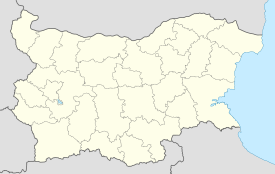| Round Church Кръгла църква | |
|---|---|
 The ruins of the Round Church in Preslav. View from the atrium entrance looking towards the narthex and rotunda gates, with the apse in the distance | |
| Religion | |
| Affiliation | Bulgarian Orthodox Church |
| Ecclesiastical or organizational status | Cathedral |
| Year consecrated | Early 10th century, possibly before 907 |
| Status | Preserved |
| Location | |
| Location | Veliki Preslav, Shumen Province, Bulgaria |
| Geographic coordinates | 43°08′32″N 26°48′47″E / 43.1423°N 26.81295°E |
| Architecture | |
| Type | Cathedral |
| Style | Early Byzantine, possible Caucasian and/or Carolingian influences |
| Specifications | |
| Direction of façade | West |
| Length | 38.5 m (126 ft) (with atrium) |
| Width | 14.30 m (46.9 ft) (atrium) 10.50 m (34.4 ft) (rotunda) |
| Dome(s) | 1 |
| Dome dia. (outer) | 10.50 m (34.4 ft) |
The Round Church (Bulgarian: Кръгла църква, Kragla tsarkva), also known as the Golden Church (Златна църква, Zlatna tsarkva) or the Church of St John (църква "Свети Йоан", tsarkva "Sveti Yoan"), is a large partially preserved early medieval Eastern Orthodox church. It lies in Preslav, the former capital of the First Bulgarian Empire, today a town in northeastern Bulgaria. The church dates to the early 10th century, the time of Tsar Simeon I's rule, and was unearthed and first archaeologically examined in 1927–1928.
Considered to be one of the most impressive examples of medieval Bulgarian architecture, the Round Church takes its name from the distinctive shape of one of its three sections, the cella (naos), which is a rotunda that serves as a place of liturgy. The church's design also includes a wide atrium and a rectangular entrance area, or narthex, marked by two circular turrets.
The church has been likened to examples of religious architecture from the late Roman (Early Christian) period, the Caucasus, and the Carolingian Pre-Romanesque of Charlemagne because of its characteristic plan, which is significantly different from contemporaneous Bulgarian or Byzantine buildings. The church's alternative name, the Golden Church, stems from its possible and popular identification with a "new golden church" in Preslav referenced in a medieval literary source.
The Round Church's rich interior decoration, which makes ample use of mosaics, ceramics and marble details, distinguishes it from other churches in Preslav. Its interior features hundreds of drawings depicting ships, fauna, and Christian figures. Medieval inscriptions on the walls range from names of saints in Byzantine Greek to separate letters and short texts in the Glagolitic and Cyrillic alphabets.
